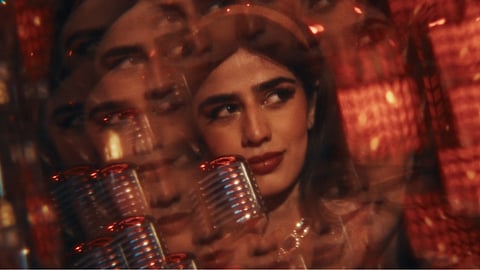
- HOMEGROWN WORLD
- #HGCREATORS
- #HGEXPLORE
- #HGVOICES
- #HGSHOP
- CAREERS
- ABOUT US
- CONTACT US

A young and beautiful singer with a magnetic presence stands under a haze of club lights, radiant in sequins, surrounded by adoring fans in an imagined 1980s Bollywood nightclub. She is everything she’s supposed to be — glamorous, adored, on stage. But something is off. In the midst of the cheering fans, what should have been a triumphant moment feels unsettling. She kisses her silk handkerchief and throws it to the crowd, but the kiss leaves no mark, as if she were never there.
With Zehreen Razi as the protagonist played by Alisha Chopra, this is the world that 'Sitara' takes us back into, the world of female Bollywood stars. Directed by Aashna Singh whose vision sits at the intersection of memory, performance, and feminine resistance, Sitara unfolds as a meditation on the simmering ache of invisibility. Its glittering 4-minute runtime may recall the razzle-dazzle of classic Bollywood, but at its core, the film is a critique: of the insidious erasure of the self beneath spectacle.
The metaphor at the centre of Sitara is both simple and incisive — a transfer-proof lipstick. Inserting this modern product into a fictional 1980s setting, the creator draws attention to the absurd expectations placed on every artist and every performer, who dreams of leaving a mark in the world. It also speaks to the relentless pursuit of perfection and how sometimes in order to achieve that we polish ourselves to the point where we lose our edge; the very thing that makes us stand out in the first place.
The contradiction of being a public figure especially as a woman, is articulated in the lines "...Chupne ki na koi jagah, dikhti nahin hun kyun magar..." which refers to being hyper-visible yet fundamentally misunderstood. It captures the vulnerability of occupying the spotlight without really being seen. This is not just the tragedy of fame, but a larger commentary on how female performers are perceived through the lens of the male gaze. Their emotional truth, their inner chaos, their attempts at resistance are often filtered out by the soft focus of desire.
Shot by acclaimed cinematographer Piyush Puty, with music by Madboy (Imaad Shah) featuring Sanah Abbott, the film’s visual and sonic language embraces the excess of disco-era India. Glittering lights, synthetic beats, and stylised camera movements create a world that is both nostalgic and uncanny. But beneath the aesthetic delight, Sitara is also a descent into madness.
Through a surreal tale about the slow-burning implosion the limelight brings, Sitara offers a sobering reflection on beauty politics and the fragile line between performance and personhood. It highlights the gritty reality of many female artists who leave their legacy behind in the world but lose themselves in the process.
Video Credits: Directed by Aashna Singh
Music by Imaad Shah ft. Sanah Abbott
Starring - Alisha Chopra, Pranav Mehra
Cinematography by Piyush Puty
Edited by Daanish Shastri
Colourist - Himanshu Kamble (Bridge PostWorks)
Production Design by Karan Gupta
Hair & Makeup by Divya Giri
Produced by Aashna Singh, Alisha Chopra
Co Produced by Anoushka Babur, Karan Gupta
Watch the video at the top of the page.
If you enjoyed reading this here's more from Homegrown:
Wes Anderson, Tupac, & Hot Assassins: KR$NA Marks His Return In An Outrageous Music Video
Chaar Diwaari’s Latest Music Video Sees Him (Literally) Wrestling With Imposter Syndrome
St. Cyril's New Music Video Punches Back At Weaponized Therapy Speak
